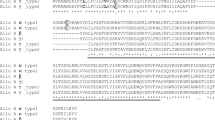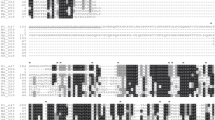Abstract
Two closely related cDNA fragments, named pTC14-1 and pTC14-2, encoding C-type lectins were cloned from the budding ascidian Polyandrocarpa misakiensis by means of the polymerase chain reaction. The amino acid sequence deduced from pTC14-1 was identical to that of a 14-kDa calcium-dependent galactose-binding lectin, TC-14, that had been purified from this species. Between the two clones, nucleotide sequence similarity was 90%, whilst that of the deduced amino acid sequences was 82%. The cDNA inserts of these clones hybridized weakly with each other. Antisense RNA probes prepared from these clones gave intense hybridization signals on Northern blots of the W strain, but very weak signals on those of the other strains. Therefore, both clones were suggested to originate from the W strain, but from two separate genes, since the base substitution was scattered throughout the entire translated region. The amount of TC14-1 mRNA increased during bud development, and peaked at 36 h after separation of the bud from the parental body wall. At this stage, extracellular matrix containing TC-14 lectin developed in the mesenchymal space around the morphogenetic region of the bud. There was much less TC14-2, than TC14-1 mRNA at every stage of bud development. TC14-1 and TC14-2 mRNAs were detected on Northern blots of RNAs from adults and growing buds, suggesting that these genes can be used as the earliest markers of budding in this species.
Similar content being viewed by others
References
Bevilacqua MP, Nelson RM (1993) Selectins. J Clin Invest 91: 379–387
Chomczynski P, Sacchi N (1987) Single-step method of RNA isolation by acid guanidinium thiocyanate-phenol-chloroform extraction. Anal Biochem 162:156–159
Drickamer K (1988) Two distinct classes of carbohydrate-recognition domains in animal lectins. J Biol Chem 263:9557–9560
Fujiwara S, Kawamura K (1992) Ascidian budding as a transdifferentiation-like system: multipotent epithelium is not undifferentiated. Dev Growth Differ 34:463–472
Fujiwara S, Kawahara H, Makabe KW, Satoh N (1993) A complementary DNA for an ascidian embryonic nuclear antigen Hgv2 encodes a protein closely related to the amphibian histone-binding protein N1. J Biochem 113:189–195
Gubler U, Hoffman BJ (1983) A simple and very efficient method for generating cDNA libraries. Gene 25:263–269
Hara K, Fujiwara S, Kawamura K (1992) Retinoic acid can induce a secondary axis in developing buds of a colonial ascidian, Polyandrocarpa misakiensis. Dev Growth Differ 34:437–445
Hashimoto K, Watanabe H (1982) Spawning as affected by light conditions in the compound ascidian, Polyandrocarpa misakiensis. Proc Jpn Acad 58:9–12
Kawamura K, Fujiwara S (1994) Transdifferentiation of pigmented multipotent epithelium during morphallactic development of budding tunicates. Int J Dev Biol 38:369–377
Kawamura K, Nakauchi M (1991) Homeostatic integration of stem cell dynamics during palleal budding of ascidians. Zool Sci 8:11–22
Kawamura K, Fujiwara S, Sugino YM (1991) Budding-specific lectin induced in epithelial cells is an extracellular matrix component for stem cell aggregation in tunicates. Development 113:995–1005
Kawamura K, Hara K, Fujiwara S (1993) Developmental role of endogenous retinoids in the determination of morphallactic field in budding tunicates. Development 117:835–845
Kubo T, Natori S (1987) Purification and properties of a lectin from the hemolymph of Periplaneta americana (American cockroach). Eur J Biochem 168:75–82
Kubo T, Kawasaki K, Natori S (1990) Sucrose-binding lectin in regenerating cockroach (Periplaneta americana) legs: its purification from adult hemolymph. Insect Biochem 20:585–591
Kubo T, Kawasaki K, Natori S (1993) Transient appearance and localization of a 26-kDa lectin, a novel member of the Periplaneta lectin family, in regenerating cockroach leg. Dev Biol 156:381–390
Saiki RK, Gelfand DH, Stoffel S, Scharf SJ, Higuchi GT, Horn GT, Mullis KB, Erlich HA (1988) Primer-directed enzymatic amplification of DNA with a thermostable DNA polymerase. Science 239:487–491
Sambrook J, Fritsch EF, Maniatis T (1989) Molecular cloning: a laboratory manual, 2nd edn. Cold Spring Harbor Laboratory, New York
Sanger F, Nicklen S, Coulson AR (1977) DNA sequencing with chain-terminating inhibitors. Proc Nail Acad Sci USA 74: 5463–5467
Suzuki T, Takagi T, Furukohri T, Kawamura K, Nakauchi M (1990) Acalcium-dependent galactose-binding lectin from the tunicate Polyandrocarpa misakiensis. J Biol Chem 265:1274–1281
Takahashi H, Komano H, Natori S (1986) Expression of the lectin gene in Sarcophaga peregrina during normal development and under conditions where the defense mechanism is activated. J Insect Physiol 32:771–779
Vasta GR, Hunt JC, Marchalonis JJ, Fish WW (1986) Galactosyl-binding lectins from the tunicate Didemnum candidum. Purification and physiochemical characterization. J Biol Chem 261: 9174–9181
Watson ML, Kingsmore SF, Johnston GI, Siegelman MH, Le Beau MM, Lemons RS, Bora NS, Howard TA, Weissman IL, McEver RP, Seldin MF (1990) Genomic organization of the selectin family of leukocyte adhesion molecules on human and mouse chromosome 1. J Exp Med 172:263–272
Author information
Authors and Affiliations
Rights and permissions
About this article
Cite this article
Shimada, M., Fujiwara, S. & Kawamura, K. Expression of genes for two C-type lectins during budding of the ascidian Polyandrocarpa misakiensis . Roux's Arch Dev Biol 204, 406–411 (1995). https://doi.org/10.1007/BF00360486
Received:
Accepted:
Issue Date:
DOI: https://doi.org/10.1007/BF00360486




